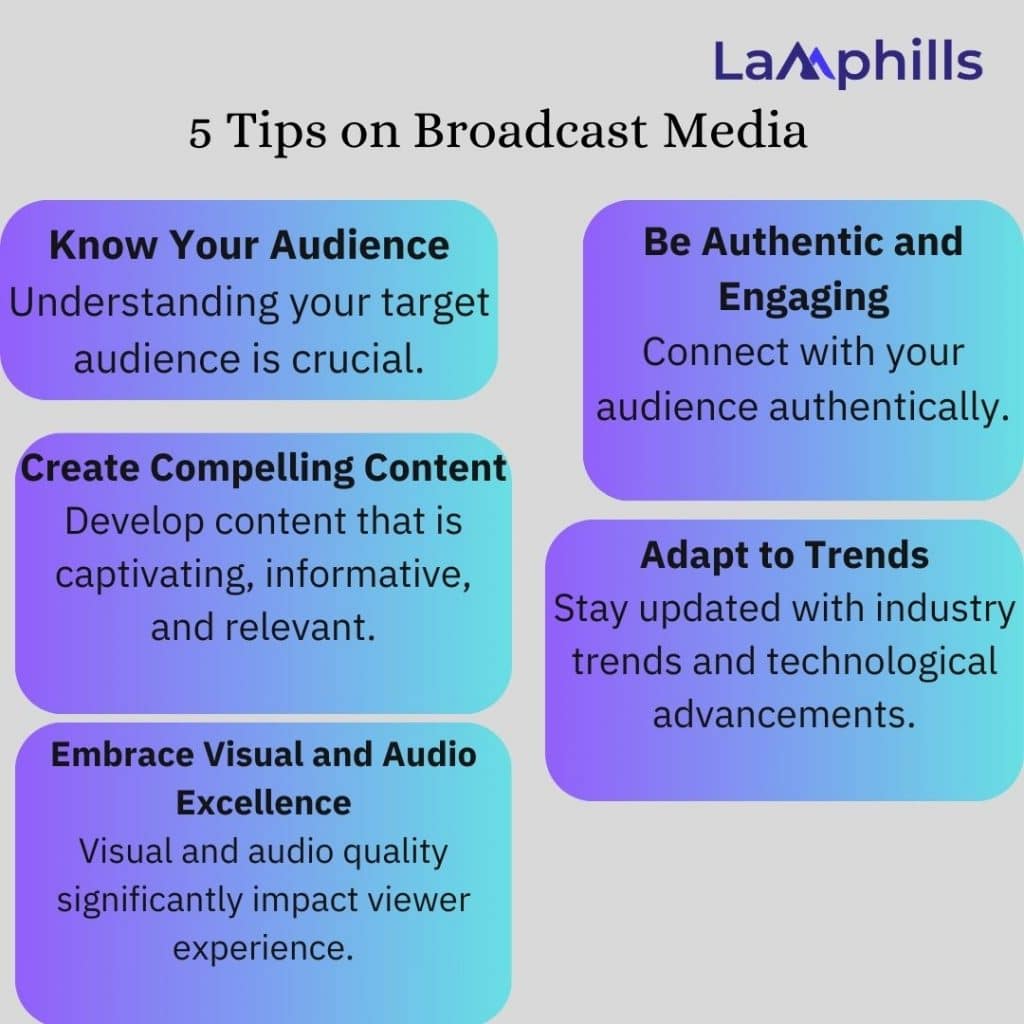Have you ever thought about diving into the world of broadcast media? It’s quite the adventure, honestly. Ever find yourself unsure of where to start? That’s totally okay. Every discovery, whether it’s the sheer variety of channels and shows out there or the fascinating behind-the-scenes work, feels like uncovering hidden treasures. It adds to your understanding and appreciation of what’s happening in this field. Isn’t it wild how the world of communication is always shifting?
My journey into broadcast media has been pretty eye-opening. From the get-go, learning the ropes of what broadcast media entails, exploring original examples, and discovering the various jobs available in this field, every step has felt like a lesson itself.
So, why am I sharing all this? Well, I hope to shed some light and guide you through the exciting world of broadcast media.
Let’s get started!
Key Point
- Broadcast media includes television, radio, the internet, and other digital platforms that simultaneously distribute content to a large audience.
- There are two main types of broadcast media: AUDIO, which includes radio, podcasts, and any content delivered through sound, and VIDEO, which encompasses television, online streaming, and any visual-based content.
- Key examples of broadcast media platforms include television (both digital and analog), radio, and internet media like websites, blogs, and podcasts.
- Broadcast media production involves creating, managing, and distributing content across various platforms, including television, radio, and online.
- Broadcast media plays several critical roles, including delivering news, providing analysis, educating, fostering community, and offering entertainment.
What is Broadcast Media?

Credit: Freepik
Imagine you’re sitting in your living room holding a remote control. You’re flipping through channels on the TV, catching snippets of news reports, a cartoon, a cooking show, and maybe a live sports game. Each channel is broadcasting its content, hoping to catch your interest. At the same time, your sibling is in the next room, streaming their favorite podcast over the internet, while your friend texts you about a trending tweet they just read.
This everyday scene is a perfect example of broadcast media in action. The TV channels, radio stations your sibling is listening to, and even the social media platforms and websites sharing news and entertainment content are all part of it. Broadcast media uses a variety of channels and technologies, like the airwaves for radio and TV and the internet for streaming services and social media, to distribute content to us, the audience, simultaneously.
Its primary goal is to keep us informed about what’s happening worldwide, entertain us with shows, movies, and music, and engage us through interactive platforms like social media. Whether it’s breaking news, the latest hit series, or a live broadcast of a major sports event, broadcast media brings the world to our living room, keeping us connected, entertained, and informed.
Broadcast Media Example
Examples of Broadcast Media are:
#1. Television (Digital and Analog)
Television is a traditional form of broadcast media that transmits audio and video content to a wide audience. Analog television uses analog signals to transmit pictures and sounds, while digital television uses digital signals, offering better picture and sound quality, as well as the ability to broadcast multiple channels in the same capacity.
#2. Radio
Radio is one of the oldest forms of broadcast media, primarily focusing on audio content. It includes music, news, talk shows, and other types of programming. Radio broadcasts can be transmitted through airwaves in AM (Amplitude Modulation) and FM (Frequency Modulation) bands, as well as via digital formats (Digital Radio Broadcasting), which offer improved sound quality and additional services.
#3. Internet Media
This encompasses a broad range of digital platforms and formats, including websites, blogs, and podcasts. These media outlets allow for the distribution of a wide variety of content, from written articles and blog posts to audio programs (podcasts) and video content. Internet media is accessible globally, making it a powerful platform for reaching a diverse audience.
#4. Online Streaming
Online streaming refers to the real-time or on-demand audio or video content transmission over the Internet. This includes services like streaming TV shows, movies, live events, and music. Unlike traditional broadcast methods, online streaming allows viewers to watch or listen to content on various devices at their convenience, such as smartphones, tablets, computers, and smart TVs.
Each of these forms of broadcast media has its own unique features and caters to different audiences but together, they significantly contribute to the dissemination of information and entertainment across the globe.
Jobs In Broadcast Media
There are so many jobs in broadcast media, and I will list just a few of them:
- Manager, Broadcast and Media Partnerships
- Associate Creative Media Producer
- Multi-Media Journalist, Telemundo Utah
- Digital Media Producer
- Broadcast Specialist, Network Operations Center, YouTube OTT
- Digital Media Creator
- Revenue Lead, Media, Entertainment and Distribution
- Project Employee, Technical Support
- Media Assistant (Dallas)
Broadcast Media Production and Distribution

Credit: Freepik
Media production involves the creation of video and audio content for both news and entertainment purposes, to cater to diverse audiences across various distribution networks. These networks include web and mobile platforms, social media, as well as broadcast television and radio. This field is dynamic and constantly growing, offering many career opportunities.
When we dip into the world of Broadcast Media Production and Distribution, what exactly are we talking about? Broadcast Media Production and Distribution refers to creating, managing, and distributing content for television, radio, and, increasingly, online platforms. This field involves a wide range of activities, from conceptualizing and recording video and audio content, editing and post-production work, and ensuring its delivery to audiences through various channels.
Professionals might work on various projects in broadcast media production, including news broadcasts, television shows, radio programs, and streaming content. The goal is to produce engaging and informative content that meets the needs and demands of a target audience. This can involve a combination of storytelling, journalism, entertainment, and educational programming. What are your thoughts on the evolution of this field and the opportunities it presents?

What Are the Two Main Types of Broadcast Media?
There are two main types of broadcast media: AUDIO and VIDEO. Isn’t it interesting how broadcast media splits into two main types, audio and video? I’ve been thinking about how video broadcasting, with its visual imagery, has really taken off on television and the internet. It’s pretty amazing how it captures viewers with moving images, making it such a powerful tool for storytelling and sharing information, don’t you think?
But then, there’s audio broadcasting, which is all about verbal communication. It’s everywhere – radio, television, and online. It’s fascinating how audio broadcasting utilizes sound alone to deliver content, making it highly accessible for people on the move or those who are visually impaired. From talk shows and news reports to music and podcasts, the range of content is just so varied. I’m curious, how do you see both video and audio broadcasting shaping our media landscape? They both seem to serve different preferences and needs, right?
What Is a Broadcast Example?
One example of broadcast is National Public Radio (NPR), a highly respected source of radio journalism. They produce audio-based content in a studio, such as news stories or interviews. The content travels across a wide area through the studio’s radio transmitter on a tall tower.
What Are the Functions of the Broadcast Media?
Broadcast media fulfills several key roles, including broad purposes and more detailed ones. It plays roles in delivering news, providing analysis, educating, fostering community, and offering entertainment:
#1. Role in Delivering the News
There’s a human need to seek out news to quell curiosity, decrease uncertainty, and better grasp our place in the world. Today, we’re inundated with information, a stark contrast to the era forty years ago when a few TV networks, local radio, and newspapers were our main sources. This glut of media has heightened the race to deliver news, sometimes leading to hasty, inaccurate, or incomplete reporting.
#2. Analytical Role
Media entities offer interpretations of news in varying degrees of explicitness and ethical considerations. For instance, newspaper commentaries have traditionally provided clear views on current affairs, and nowadays, cable TV and radio hosts deliver social, cultural, and political analyses filled with personal viewpoints. While some may blur the lines of ethical standards by appearing as conventional news sources, most are upfront about their biases.
#3. Educational Role
Specific media channels focus on educating the audience beyond mere news transmission. While main news channels like CNN and BBC are primarily informational, networks such as Fox News and MSNBC blend news with analysis. Meanwhile, National Public Radio and the Public Broadcasting Service offer comprehensive coverage, and channels like the History Channel, National Geographic Channel, and Discovery Channel aim to educate through engaging and somewhat dramatized content.
#4. Community-Building Role
Media has the power to connect individuals, fulfilling a community-building role. Online forums allow those with shared interests to connect, and large audiences can come together during the broadcast of significant events, such as the 9/11 attacks or severe weather incidents.
#5. Entertainment Role
Media also serves as an escape from the routine of daily life, providing distraction, amusement, or relaxation. Whether taking a break from studying for exams or simply unwinding, the media’s role in entertainment is crucial to its function.
Checklist on Broadcast Media Production
What Are the Characteristics of Broadcast Media?
Multimedia Sensory Appeal: Television advertising and programs have the unique advantage of engaging viewers through visuals and sound, making it an effective platform for captivating and persuading audiences.
Immediate and Informative: Today’s broadcast landscape heavily focuses on news, with many networks providing between 5 to 9 hours of news coverage daily. This makes television an essential source of up-to-date information, especially during emergencies, thanks to its ability to broadcast live events swiftly.
Broad Audience Reach: Known for its extensive reach, television allows advertisers to efficiently target specific demographics using detailed research and analysis. Tools such as Nielsen and comScore ratings, Scarborough research, and media planning software like BluHorn are commonly utilized to optimize advertising reach within a given budget.
Accessibility and Routine Integration: Television provides a convenient source of information and entertainment, becoming a staple in many daily routines. Viewers often schedule their day around their preferred TV programs, from morning news shows like the Today Show or Good Morning America, to evening news, and prime-time favorites such as Big Bang Theory, Dancing with the Stars, The Voice, or NCIS.
What Are the Advantages and Disadvantages of Broadcast Media?
Advantages of Broadcast Media Advertising
- When content is disseminated through televised media, it has the potential to reach a large audience.
- Broadcast media content, which can include audio and visual components, can influence people’s perspectives.
- Broadcast media is a highly accessible and effective form of communication.
- It can inspire creative thinking among young people and promote positive messages to its audience.
- It offers valuable information and entertaining shows, which can relieve viewers’ stress.
- Customization is possible based on consumer interests, and content can be saved for future reference.
- It is a worthwhile investment of time, as many people seek news and updates in their spare time.
- It provides in-depth coverage of various topics, such as fashion, travel, photography, politics, education, food, lifestyle, and more.
Disadvantages of Broadcast Media Advertising
- Broadcast media can hurt public attitudes and promote harmful ideas.
- It can be costly and not affordable for small and medium-sized businesses.
- Not all businesses are suitable for advertising through broadcast media.
- It may only be accessible to educated and younger audiences who use it for work and entertainment.
- Adult humor, offensive language, and nudity are often present, which can negatively affect young viewers and promote bad habits.
- Due to intense competition, there is a risk of failure.
What Is the Difference Between Mass Media and Broadcast Media?
The primary difference between mass media and televised media lies in their scope and content delivery methods. Mass media is a broad term encompassing various platforms and technologies for communicating information to a large audience. It includes not only broadcast media but also print media (such as newspapers and magazines), digital media (including social media, websites, and online publications), and outdoor media (like billboards and posters). Mass media covers all tools and formats for disseminating information and entertainment to the public on a large scale.
Broadcast media, on the other hand, refers specifically to the transmission of information electronically through media such as television and radio. It is a subset of mass media focused on distributing content through electromagnetic waves. Broadcast media traditionally reaches its audience via airwaves for television and radio, presenting news, entertainment, and educational programming. In contrast, mass media’s broader category includes any medium that can reach a wide audience, making broadcast media just one of the many ways mass media achieves its goal of mass communication.
Importance of Broadcasting Media
Broadcasting media plays a crucial role in marketing and advertising, significantly influencing public perception. Marketers often select their preferred media platforms to launch or promote their offerings. It serves as a vital channel through which companies, brands, or governmental bodies communicate their array of products and services to the audience.
The public consistently receives updates, advertisements, news, and various information across multiple channels. This involves the entire signal transmission process, content distribution to different outlets, and delivering visual and audio content to audiences.
Furthermore, it has emerged as a leading platform for promoting numerous brands and products. Contrary to popular belief, utilizing broadcast media for marketing is not as costly as it seems.
Media Coverage vs Broadcast Media
Media coverage refers to the reporting and dissemination of information about an event, person, or topic across various media channels, including newspapers, television, radio, online news platforms, and social media. It encompasses different forms such as earned media (news features and interviews), paid media (advertisements and sponsored content), owned media (company blogs and websites), and shared media (social media interactions and viral content). Media coverage plays a crucial role in shaping public perception, brand reputation, and awareness, making it a valuable tool for businesses, public figures, and organizations.
Broadcast media, on the other hand, is a specific category of mass communication that transmits information through audio-visual channels such as television, radio, and digital streaming platforms. Unlike general media coverage, which includes written and digital content, broadcast media primarily focuses on real-time or recorded transmission of news, entertainment, and educational content to a broad audience. Television news reports, radio talk shows, and live-streamed events are examples of broadcast media. While media coverage can come from various sources, broadcast media is limited to platforms that rely on electronic transmission to reach the public.
Related Post
Top Media Outlets in 2024: A Trustworthy Guide for Authoritative News Sources
Brand Advertising: Elevating Your Brand Awareness






